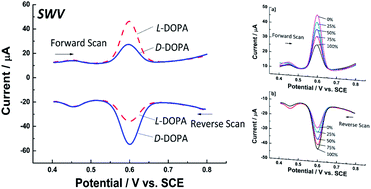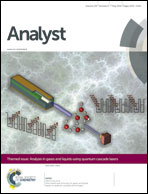A novel electrochemical chiral sensor for 3,4-dihydroxyphenylalanine based on the combination of single-walled carbon nanotubes, sulfuric acid and square wave voltammetry
Abstract
We demonstrate, for the first time, an electrochemical sensor that provides antipodal signals upon application of square wave voltammetry (SWV), for enantioselective recognition of 3,4-dihydroxyphenylalanine based on chiral single-walled carbon nanotubes (SWCNTs) in the presence of sulphuric acid. Interestingly, the enantioselectivity was not observed using the common method of cyclic voltammetry (CV) but the SWV peak currents of enantiomers were found to be quite different and hence the enantiomers could be successfully recognized. Moreover, the antipodal signals provided by two SWV scan modes offer the possibility for results to be confirmed mutually, showing a great practical value and analytical application prospects.


 Please wait while we load your content...
Please wait while we load your content...